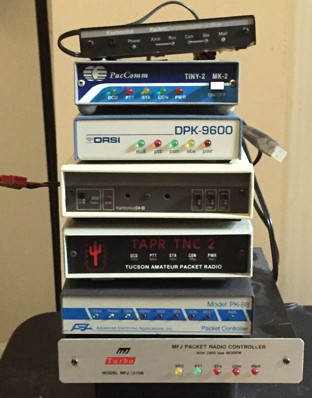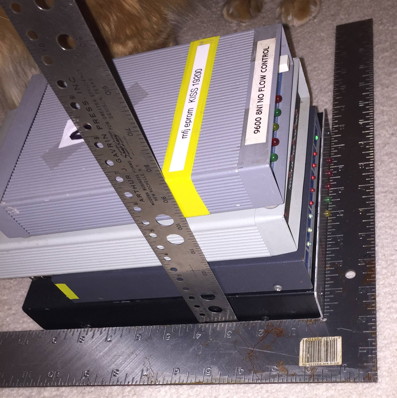Terminal Node Controller -- TNC
TNC, which means Terminal Node Controller, is a computer device that takes care of all of the dirty work involved with packet communications.
The TNCs range in price from about $10 on the used market to about $45 for a new 8-speed USB TNC kit, to $400 for advanced HF SSB two-way compensating TNCs.
You can also acquire radios that cost from $70 to $400 that have 9600 baud TNCs built in.
For the purposes of building a TARPN, the
$45 NinoTNC kit is a base level device.
Don't spend much more than that for a 1200 or 9600 baud TNC and don't suffer with a worse working device.
Packet Radio?
Packet radio allows the digital transmission and reception of messages in small chunks called packets.
At a very basic level it takes the characters in each message and translates each character as a sequence of high tones and low tones.
Each letter consists of 8 bits, each bit can be a high tone or a low tone.
The letter is preceded by a low tone and followed by a high tone (Start bit and Stop bit).
A letterC sounds like: lo lo high lo lo lo lo high high high.
The tones all run together with no silence in between and on amateur packet radio (at 1200 baud) the total length of a single character is about 8/1200ths of a second.
Thats eight bits at 1200 bits per second.
This means that a message with one hundred and fifty characters could be sent in one second.
Addresses
Each packet includes, at the start of the packet burst, the callsign of your station and the callsign of the destination station.
That means that if you chose, your station can reject any packets that are not to you.
Secondly each packet station only transmits for long enough to get across its short message.
Thus several hams can use a single frequency for conversations without having to listen to each of the other conversations.
In normal packet operation you would type a carriage return after each line of text that you are sending to another station.
After you type the carriage return your packet station will wait for a quiet moment on the frequency and then send its message.
If you have specified an intermediate station in the path to your friend then the intermediate station will hear its call in your message and will retransmit your message, only if the message is received perfectly and after the intermediate station sees the frequency quiet.
Then your friends station will hear the message and send back an acknowledgment which is picked up and echoed by the intermediate station.
When your station gets the acknowledgment it will go on and send your next line of text when you hit the next carriage return.
If you have already hit the next return then your station will immediately start looking for the frequency to get quiet and will then transmit the next line.
If your station waits for a preset amount of time and doesnt get an acknowledgment for its packet it will send another one.
This will repeat until the message gets through or your station sends RETRY amount of times, (usually 10).
The form of communications where your station waits for a quiet moment and then transmits its message is calledCarrier Sense - Multiple Access or CSMA
But what does the TNC do?
The TNC knows how to generate and interpret the signals making up packet radio.
It uses digital hardware to create the noises for transmit, and decode noises which are received, over a voice radio.
A TNC has a transmit audio level that can match the microphone input of a transceiver and can also be adjusted to do the higher voltage swing [louder] level used for data radios.
It also has a Push-To-Talk signal to key the radio.
On the other side of the circuit, a TNC has a computer connector.
Most TNCs made before year 2005 exclusively used RS-232 to talk to the computer.
More modern TNCs may be USB or some specialty bus made for an embedded computer.
TNC-PI, used between 2006 and 2019, hooked up to a computer using I2C multi-station interconnect.
This was made to be compatible with the Raspberry PI computer.
The NinoTNC uses a USB connection.
TNC in housing, by AEA, Kantronics, MFJ, TAPR, DRSI, or PacComm.
These TNCs use RS-232 serial ports and were made to plug into a dumb terminal or PC using a 9 or 25 pin D shell connector.
These can be connected to the Raspberry PI using USB to RS-232 adapter cables
which cost around $5 mail-order. One of our TARPN packet nodes, based on G8BPQ & Raspberry PI, can support 4 of these RS-232 TNCs at a time using the 2015 version TARPN configuration.
More could be supported if anybody had a call for it.

|

|
Click to zoom on these images.
On the left photo from the top:
- Kantronics KPC-3 ‑‑ current, very good, well supported.
TAPR TNC-1 derived ‑‑ Used is $50ish.
New is $200
- PacComm Tiny-2 ‑‑ a little old.
TAPR TNC-2 clone ‑‑ support is so-so ‑‑
Used is $10 to $60, usually you find them hacked up.
New is $170.
- DRSI DPK9600 ‑‑ 9600 baud TNC. TAPR TNC-2 clone with added modem ‑‑
Needs custom modified radios or special radio.
Very rare used.
Not available new.
- Kantronics D4-10 radio ‑‑ not a TNC.
Supports 19.2kbaud.
Crystal controlled usually in the 430Mhz range @ 10 watts.
very rare used.
Not available new.
- TAPR TNC-2 rev 2 ‑‑ Rev 1 had smaller memories, 4 LEDs, no Personal BBS.
Still KISS capable with appropriate EPROM.
Very rare used. Not available new.
- AEA PK-88 ‑‑ Uncertain parentage.
Good unit.
Very very solid. KISS capable.
Rare used but worth $25 to $50. Not available new.
- MFJ1270B ‑‑ TNC-2 clone ‑‑ old.
Used is $10 to $60.
Not available new.
These TNCs have various connectors. The TNC‑2 clones have 5-pin DIN for radio connector.
Kantronics is DE9, same as TNC‑PI. AEA uses 8-pin round microphone connector.
All TNCs will run on 12v unregulated DC. D4-10 radio needs regulated, I think.
There are many more TNCs made before 2005 or so which can be supported using the same cabling.
Kantronics, for instance, made a line of dual-radio TNCs supporting 300 and 1200 baud, made to support an HF radio and a VHF radio at the same time, or 1200 on one radio and 9600 on the other radio, at the same time.
I'm pretty sure we can run both radios at a time with a single TNC on the G8BPQ node code.
We'll have to try it.
There are several companies making modern TNCs which are sold to support APRS packet radio.
Some of these do not fully support the protocols required by our node software.
These include models by Argent Data.
I own a pair of Argent 1‑watt UHF 9600 baud integrated radio/TNCs based on the Tracker-3 family.
These do not allow transmission of full‑length packets and completely fail in node service.
That's too bad because they were under $100 and had USB connectors.
|